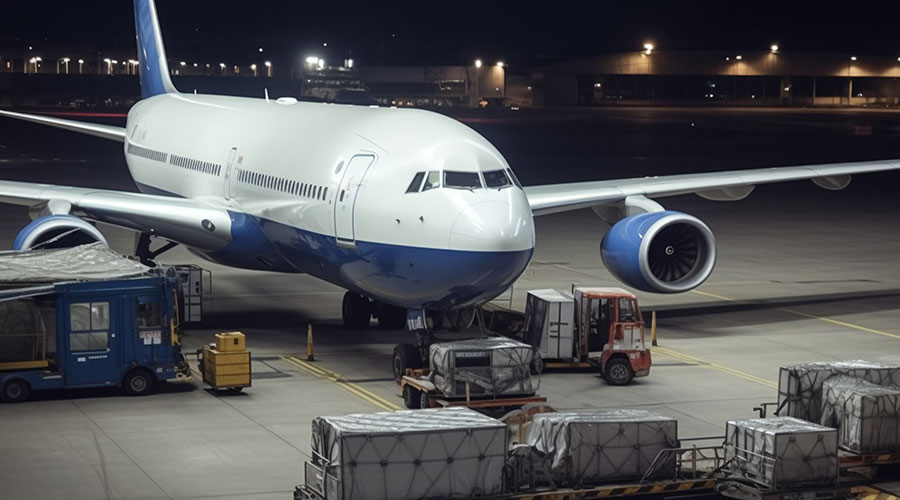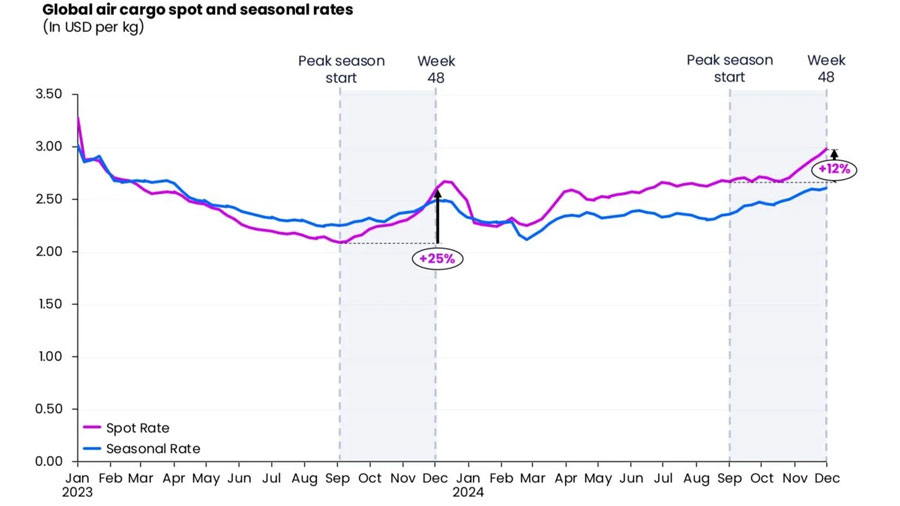

Analysts predict the air cargo bull market will cool by 50% by 2025
Miami Beach, Fla. - Prominent industry stakeholders are warning that air cargo growth could drop by half or more in 2025 from this year's high levels. The forecast is in line with data showing that air cargo demand momentum continued unabated in November, traditionally a super busy month when cargo volumes reach their highest point of the year.
Air cargo is expected to grow by 1% to 2% in 2024. After 12 consecutive months of double-digit growth and rising earnings, many air logistics professionals are looking forward to a good time to move on.
But Danish logistics giant DSV said in a quarterly analysis published on Monday that it expects air cargo volumes in 2025 to be flat compared to this year, as companies have fully adjusted to disruptions in seaborne supply chains, leading to more cargo being moved by air and cross-border e-commerce winding down. If the forecast comes true, it would mark a significant change from the 11% year-over-year increase in air traffic so far in 2024. This will also follow the normal 15 to 20 month cycle of the air cargo industry.
DSV predicts that the surge in e-commerce demand in the Chinese market will slow as many markets are already flooded with sellers and governments such as the United States are enacting stricter customs rules for low-value goods that evade import duties and compliance requirements.
Kathy Liu, executive vice president of marketing and sales at Taiwanese logistics company CFC, said in a Cargo Buyers Club podcast that tightening the eligibility for Chinese package shipments that currently qualify for duty free could lead to some reduction in air freight volumes next year and beyond. But Chinese sellers such as Temu, Shein and AliExpress are already adjusting their fulfillment models, sending frequently ordered products by sea and shipping them from U.S. warehouses.
Cargo analytics firm Xeneta forecasts that air cargo demand will grow 4 to 6 percent next year, depending on trade routes, while capacity will grow 4 to 5 percent.
Air logistics stakeholders also expressed concern that the capacity squeeze on main-deck freighters could worsen as older aircraft are being retired due to age constraints, manufacturing difficulties resulting in a slowdown in freighter deliveries and delays in the approval of the Boeing 777-300 freighter conversion program.
British Airways, Lufthansa, SAS and Virgin Atlantic have reduced passenger frequencies and cancelled routes because of the cost of extra flying time around Russian airspace. Russian airspace has been closed to Western airlines since the Ukrainian invasion. Starting in January, KLM will reduce its daily flights to China.
Ryan Keyrouse, CEO and co-founder of strategy consultancy Rotate, predicts that the supply situation will limit air cargo volumes next year.
In a speech at the International Air Cargo Association trade show last month, he said air cargo capacity will grow at a rate of up to 4.4 percent next year, not including any aircraft retirements. He elaborated in an email that in the current environment of high yields and low oil prices, airlines will postpone the decommissioning of freighters for as long as possible, but there are not enough freighters to meet demand.
"Given that belly capacity on freight-related routes does not always increase and airlines have limited ability to shift capacity, we believe demand growth will be lower than capacity growth," he told FreightWaves. Based on Rotate's criteria, this could mean an increase in air cargo volumes of less than 4%.
On the positive side, longshoremen on the U.S. East Coast and Gulf Coast are set to go on strike in mid-January over concerns that port management is interested in partially automating container operations, which could benefit air cargo. If negotiations remain deadlocked, companies are expected to transfer key cargo to airlines.
While the change in minimum regulations could negatively impact e-commerce, it could also lead to an increase in air cargo volumes in the first half of the year if shippers pre-purchase inventory to avoid potential tariffs. Speaking at the event, Keyrouse said that developing markets with low e-commerce penetration will offer huge growth potential for air cargo, as major online retailers target Latin America, Southeast Asia and the Middle East.
Iata Director General Willie Walsh said in a press release on Tuesday: "While 2024 promises to be a banner year for air cargo, we must view 2025 with caution. The incoming Trump administration has announced its intention to impose steep tariffs on its major trading partners - Canada, China and Mexico - which could upend global supply chains and undermine consumer confidence. As the Trump agenda unfolds, the air cargo industry's ability to adapt to the rapidly changing geopolitical and economic landscape may be tested."
Has growth peaked?
Xeneta's latest data shows that airlines carried 10 percent more volume by weight in November than in the same month last year, continuing a streak of double-digit monthly growth since December. But WorldACD reports that there are signs that growth may be slowing earlier than normal in mid-December, as global tonnage growth was flat in the last week of November compared to the previous week.
(IATA, which calculates demand differently and reports a month later than other airlines, said air cargo volumes rose 9.8 percent in October from a year earlier, compared with Xeneta's 11 percent.)
Air logistics executives had expected a lacklustre season, as demand has risen due to diversions caused by unreliable shipping, companies placing orders ahead to minimise potential delays and a steady stream of e-commerce exports from China, regardless of the season. In fact, carriers on major Chinese routes report that they are busy but not yet overwhelmed.
Freight capacity in the fourth quarter was only about 3 percent higher than a year earlier. All-freighters are highly utilised and are almost always fully loaded on major routes from Asia to North America and Europe. Despite the severe imbalance between supply and demand, the market is fairly stable, and there is not the chaotic scramble for space as there was a year ago.
According to Xeneta, demand is growing faster than supply, causing global short-term air freight rates to reach their highest level in nearly two years in November, reaching $2.90 per kilogram, the sixth consecutive month of double-digit year-on-year growth. Spot freight exceeds contract freight. The continued supply and demand balance pushed load factor, a measure of capacity utilization, to 63 percent, the highest level in more than 30 months.
The North American and European markets are seeing the most pressure on freight rates, mainly as airlines restructure their cargo fleets to take advantage of high demand and yields in the Asia Pacific region.
According to WorldACD, westbound transatlantic rates rose 8 per cent a week, while eastbound trans-Pacific rates to North America were flat. More specifically, average freight rates from China to North America actually fell 4 percent from the previous week to $6.62 per kilogram, while weekly freight rates from China to Northern Europe fell 10 percent - a result of more aircraft and companies planning ahead to adjust their shipping schedules, Freightos, the freight market and Pricing index, said.
Niall van de Wouw, chief air cargo officer at Xeneta, attributed the chaos to better inventory management and advance preparation by carriers and freight forwarders.
"Shippers are much better prepared and have terms and conditions in place to make sure they [book capacity in advance] so we don't see the crazy rates we saw last year." I think it's a great compliment to the industry that they're able to move so much for businesses and consumers around the world at that price, "he said during a webinar hosted by logistics provider Flexport on Tuesday.
E-commerce effect
Experts and logistics providers say e-commerce has been the driver of air cargo growth over the past 15 months, with more than half of China's air exports going through online marketplaces. Research from eMarketer shows that global e-commerce sales have doubled in the past five years to more than $6 trillion and are growing at around 8% a year, with emerging markets such as South and Southeast Asia developing rapidly. The firm expects B2C e-commerce sales to reach $8 trillion by 2027, accounting for more than 22 percent of total retail sales.
But Adriaan den Heijer, executive vice president of Air France-KLM Cargo, told the Flexport webinar that the e-commerce wave has also masked a decline in other airfreight goods, such as auto parts and pharmaceuticals, which have started to shift to sea freight.
"If you take away the Red Sea [shipping closures] and the impact of e-commerce, there's only a small percentage of traditional B2B air freight left," van der Wouw added.
Air cargo is expected to grow by 1% to 2% in 2024. After 12 consecutive months of double-digit growth and rising earnings, many air logistics professionals are looking forward to a good time to move on.
But Danish logistics giant DSV said in a quarterly analysis published on Monday that it expects air cargo volumes in 2025 to be flat compared to this year, as companies have fully adjusted to disruptions in seaborne supply chains, leading to more cargo being moved by air and cross-border e-commerce winding down. If the forecast comes true, it would mark a significant change from the 11% year-over-year increase in air traffic so far in 2024. This will also follow the normal 15 to 20 month cycle of the air cargo industry.
DSV predicts that the surge in e-commerce demand in the Chinese market will slow as many markets are already flooded with sellers and governments such as the United States are enacting stricter customs rules for low-value goods that evade import duties and compliance requirements.
Kathy Liu, executive vice president of marketing and sales at Taiwanese logistics company CFC, said in a Cargo Buyers Club podcast that tightening the eligibility for Chinese package shipments that currently qualify for duty free could lead to some reduction in air freight volumes next year and beyond. But Chinese sellers such as Temu, Shein and AliExpress are already adjusting their fulfillment models, sending frequently ordered products by sea and shipping them from U.S. warehouses.
Cargo analytics firm Xeneta forecasts that air cargo demand will grow 4 to 6 percent next year, depending on trade routes, while capacity will grow 4 to 5 percent.

Air logistics stakeholders also expressed concern that the capacity squeeze on main-deck freighters could worsen as older aircraft are being retired due to age constraints, manufacturing difficulties resulting in a slowdown in freighter deliveries and delays in the approval of the Boeing 777-300 freighter conversion program.
British Airways, Lufthansa, SAS and Virgin Atlantic have reduced passenger frequencies and cancelled routes because of the cost of extra flying time around Russian airspace. Russian airspace has been closed to Western airlines since the Ukrainian invasion. Starting in January, KLM will reduce its daily flights to China.
Ryan Keyrouse, CEO and co-founder of strategy consultancy Rotate, predicts that the supply situation will limit air cargo volumes next year.
In a speech at the International Air Cargo Association trade show last month, he said air cargo capacity will grow at a rate of up to 4.4 percent next year, not including any aircraft retirements. He elaborated in an email that in the current environment of high yields and low oil prices, airlines will postpone the decommissioning of freighters for as long as possible, but there are not enough freighters to meet demand.
"Given that belly capacity on freight-related routes does not always increase and airlines have limited ability to shift capacity, we believe demand growth will be lower than capacity growth," he told FreightWaves. Based on Rotate's criteria, this could mean an increase in air cargo volumes of less than 4%.
On the positive side, longshoremen on the U.S. East Coast and Gulf Coast are set to go on strike in mid-January over concerns that port management is interested in partially automating container operations, which could benefit air cargo. If negotiations remain deadlocked, companies are expected to transfer key cargo to airlines.
While the change in minimum regulations could negatively impact e-commerce, it could also lead to an increase in air cargo volumes in the first half of the year if shippers pre-purchase inventory to avoid potential tariffs. Speaking at the event, Keyrouse said that developing markets with low e-commerce penetration will offer huge growth potential for air cargo, as major online retailers target Latin America, Southeast Asia and the Middle East.
Iata Director General Willie Walsh said in a press release on Tuesday: "While 2024 promises to be a banner year for air cargo, we must view 2025 with caution. The incoming Trump administration has announced its intention to impose steep tariffs on its major trading partners - Canada, China and Mexico - which could upend global supply chains and undermine consumer confidence. As the Trump agenda unfolds, the air cargo industry's ability to adapt to the rapidly changing geopolitical and economic landscape may be tested."
Has growth peaked?
Xeneta's latest data shows that airlines carried 10 percent more volume by weight in November than in the same month last year, continuing a streak of double-digit monthly growth since December. But WorldACD reports that there are signs that growth may be slowing earlier than normal in mid-December, as global tonnage growth was flat in the last week of November compared to the previous week.
(IATA, which calculates demand differently and reports a month later than other airlines, said air cargo volumes rose 9.8 percent in October from a year earlier, compared with Xeneta's 11 percent.)
Air logistics executives had expected a lacklustre season, as demand has risen due to diversions caused by unreliable shipping, companies placing orders ahead to minimise potential delays and a steady stream of e-commerce exports from China, regardless of the season. In fact, carriers on major Chinese routes report that they are busy but not yet overwhelmed.
Freight capacity in the fourth quarter was only about 3 percent higher than a year earlier. All-freighters are highly utilised and are almost always fully loaded on major routes from Asia to North America and Europe. Despite the severe imbalance between supply and demand, the market is fairly stable, and there is not the chaotic scramble for space as there was a year ago.
According to Xeneta, demand is growing faster than supply, causing global short-term air freight rates to reach their highest level in nearly two years in November, reaching $2.90 per kilogram, the sixth consecutive month of double-digit year-on-year growth. Spot freight exceeds contract freight. The continued supply and demand balance pushed load factor, a measure of capacity utilization, to 63 percent, the highest level in more than 30 months.
The North American and European markets are seeing the most pressure on freight rates, mainly as airlines restructure their cargo fleets to take advantage of high demand and yields in the Asia Pacific region.
According to WorldACD, westbound transatlantic rates rose 8 per cent a week, while eastbound trans-Pacific rates to North America were flat. More specifically, average freight rates from China to North America actually fell 4 percent from the previous week to $6.62 per kilogram, while weekly freight rates from China to Northern Europe fell 10 percent - a result of more aircraft and companies planning ahead to adjust their shipping schedules, Freightos, the freight market and Pricing index, said.

Niall van de Wouw, chief air cargo officer at Xeneta, attributed the chaos to better inventory management and advance preparation by carriers and freight forwarders.
"Shippers are much better prepared and have terms and conditions in place to make sure they [book capacity in advance] so we don't see the crazy rates we saw last year." I think it's a great compliment to the industry that they're able to move so much for businesses and consumers around the world at that price, "he said during a webinar hosted by logistics provider Flexport on Tuesday.
E-commerce effect
Experts and logistics providers say e-commerce has been the driver of air cargo growth over the past 15 months, with more than half of China's air exports going through online marketplaces. Research from eMarketer shows that global e-commerce sales have doubled in the past five years to more than $6 trillion and are growing at around 8% a year, with emerging markets such as South and Southeast Asia developing rapidly. The firm expects B2C e-commerce sales to reach $8 trillion by 2027, accounting for more than 22 percent of total retail sales.
But Adriaan den Heijer, executive vice president of Air France-KLM Cargo, told the Flexport webinar that the e-commerce wave has also masked a decline in other airfreight goods, such as auto parts and pharmaceuticals, which have started to shift to sea freight.
"If you take away the Red Sea [shipping closures] and the impact of e-commerce, there's only a small percentage of traditional B2B air freight left," van der Wouw added.





